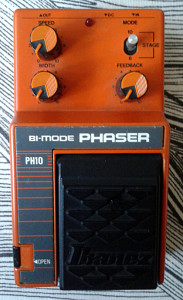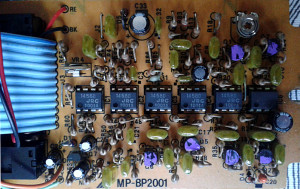What is it?
Ibanez PH10 Bi-Mode Phaser from Power series, made in japan between 1986-89.
One of the nicest phasers. The Bi-Mode here means that the phasing stages are switchable between six and ten stages. Which is not a bad idea to throw in to a huge bowl of phasers. Got this unit for a reasonable price from J. Linden of Linden guitars. As i tried it out, i felt like the six stage mode was losing the phase from most of the sweep. That could only mean one thing. The unit had went misbiased over time. I’ve seen this happen with new units too, so it’s not that uncommon. Biasing the JFETs with the trimmer is a bit of pain on this one, but i think i nailed in the first 5 minutes or so. So all i needed to get this unit running properly was a screwdriver and a hint of patience.
As most of you may already know, i’m a sucker for symmetry on the board layouts. The idea of placing all six ICs in a single row is a heart warming visual candy.
As for the design.. As the photo below shows, there are six JFETs responsible for the phasing. So how does it become 10-stage phaser just by a flick of the switch? The design sort of re-uses the first four stages in the 10-stage mode. Quite an elegant solution. You should be able to find the factory schematic PDF through your favourite search engine. I’m not linking it here..
The feedback control takes the signal from output filter and pushes it back to the beginning of the phasing stages through the one half of a dual opamp which is there, just to drive the feedback. This is very nice feature as well. I’ve seen this type of feedback network used a lot on different flanger designs, but not in many phasers.
So. In general this is pretty versatile and neatly designed phaser. Definitely more usable than the standard and overly cloned Phase 45, 90 or 100.
How does it sound?
Like a good phaser tool with lots of versatility on the controls. On six stage setting it is not that far away from Phase 100, but the feedback control lets you tweak this to a lot thicker and much more psychedelic swirls. Now if we take the ten stage setting, the sweeps and swirls get even more depth and psych on. The slow ambient sweeping on both, 6 and 10 stage settings are really good sounding and usable too. Once again, the feedback control takes the trophy home. Very good phaser.




hi Miro!
First, thanks for contributions to tagboardeffects site – use it alot (actually, start pedal-building from it and can’t stop)! I have similar phaser – BI-Stage BPL which is predecessor of this pedal. One question about width control – does it change the ‘sweep’ of the effect (ccw – more bass, full cc – more highs) ?
Another question about tagboard: maybe it would be useful to add summary post with “outcast” pedals, e.g. many ICs to the vero, clones of originals, cmos devices, untraced devices etc…
Last question (related to second one):request for Emma Discumbobulator (they say MXR envelope filter with ggg mods)
Hi.
I’m quite slow on answering to posts at any site at the moment with so much other stuff going on.. About the BPL/PH10 (which both are the same circuit), the frequency responce shouldn’t be affected by the width at all. That simply controls the amplitude of the LFO, and as such, it shouldn’t affect anything else but the sweep.
About Tagboard.. Your best bet is to ask at the forum there. I’m sure we’ll be back with more layouts when some other stuff settles. It’s been very slow few months…
+m